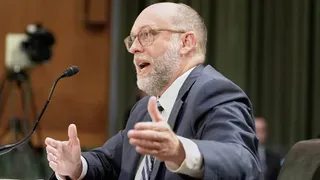July 4, 2013
Is the Catholic Church Overripe With Gay Scandal?
Antoinette Weil READ TIME: 6 MIN.
News of a so-called "gay hookup site for priests" rocked the right-wing Catholic community last month and provided cause for discussion, if not outright mockery, for all the rest.
Italian press first broke the story of Venerabilis, the "Homosensible Roman Catholic Priests Fraternity," which not only operates out of the Vatican on a public blogspot platform, but even has its own Twitter account. This controversy, combined with Pope Francis' recent mention of a "gay lobby" within the Church, has prompted a media frenzy and a shocking look at the LGBT truth of the Roman Catholic Church.
Perhaps what is most shocking about all of this, is that for those close to the Vatican, it is not shocking at all.
"The first thing is you've got to know there is a great deal of sexual activity at every level, from the cardinals down," said Richard Sipe, psychotherapist, sociologist, author, and leading expert in the field of sex, celibacy, and the Catholic Church. "Everyone that has been close to the Vatican knows about the sexual activity and homosexual activity going on."
This flies in the face of the commonplace notions of celibacy and LGBT exclusion and intolerance in the Catholic Church, almost to a degree of disbelief. But Sipe is pretty convincing: A Benedictine Monk for 18 years, Sipe was trained and acted as counselor, dealing with the mental health issues of Roman Catholic Priests. During this period he conducted research for what became a 25-year ethnographic study of the celibate and sexual behavior of Catholic Priests. The 1990 publication is known as a "classic," and a reputable reference on the subject.
Just because there are priests having sex, and gay sex at that, doesn't mean they are hooking up via Internet forum Venerabilis. Does it?
EDGE, with the assistance of Google Translate, checked out the multi-lingual site and found user-posts that varied as much in their content as their geo-location. While some seemed to seek only support and friendship ("Hello to all! I am a 23-year-old guy, I live in Veneto and would like to meet new people for dialogue and support!"), others were quite obviously looking for more ("Hello everyone, I am a 40 year old boy with a beautiful body of Milan, I'd like to know a priest or seminarian roughly the same age to exchange views and intimate moments with respect [and] confidentiality").
It would be difficult to condemn Venerabilis strictly a "hookup site," but it cannot be ignored that a significant number of users are using the forum for that purpose.
The Catholic Church’s Culture of Silence
"We've had experience with this type of website before," said Marianne Duddy-Burke, executive director of DignityUSA, an LGBT advocacy and faith organization that works for social justice and equality within the Church and in society. "They often start out as gay priests under anonymity talking to each other about their struggles and feelings. What we always see happening is the connection becomes a longing for more. It spirals and usually people end up wanting to meet."
While anonymity is an option on the blog (a chat-room setup offers guests randomly-generated temporary usernames and forum contributors may post unnamed), many of Venerabilis' users choose to provide contact information. Names, email addresses, and even telephone numbers can be found on the message boards, a move that could be dangerous for those clergymen.
"There are always right-wing lurkers on sites like these, looking to bait and expose others," Duddy-Burke told EDGE.
This type of "misconduct" being brought to the attention of a bishop or higher-up could lead to firing or suspension. Or, a simple shaming and relocation could do the trick -- an alternative that has been used in numerous sex abuse cases, affirmed Sipe.
This marked culture of silence, cover-ups, and deep, dark secrets is something that the Catholic Church is being recognized for more and more. With the recent exposure of Venerabilis and the acknowledgement by the Pope of a "gay lobby" within the Vatican, it certainly seems that the unexpectedly high numbers of gay clergymen, and the ostensible tolerance of homosexuality within the confines of the Church, is yet another of those secrets making its way into the light.
Meantime, the term "lobby," as used in this context, doesn't fit the traditional definition of the word. One might be inclined to imagine a group of proud gay bishops, monks, and cardinals professing their sexuality as part of who they are, embracing diversity within the confines of the Vatican, and demanding changes be made toward equality and openness. But the reality of what this term describes is the gay presence in the hierarchy and the questionable, if not corrupt, ways of dealing with and concealing it.
Estimates of the portion of clergymen who are gay or bisexual in the Catholic Church range from 33-70 percent.
The Chicken or the Egg?
"A sound estimate," said Sipe, "is 50 percent. I have worked on this for over 50 years, and there is a great deal of evidence of that."
This is a much higher percentage than is found in the general population, and its factors could be explained in a number of ways. One theory is that in the forties, fifties, and sixties, when many of these holy men were entering into their careers in the Church, the world was a much harsher place for LGBTs. Coming out hardly seemed an option to many people, and blatant bigotry was accepted and tolerated. Another hypothesis, Sipe says, has to do with the fact that the Church hierarchy is a homo-social culture.
"Look at any of the cultures where males are isolated without females, or vice versa," said Sipe. "If you think it operates without sex, you are deceiving yourself."
This brings about a chicken vs. egg question of sorts: Are gay men drawn to the clergy? Or do clergymen simply form relationships with those who they are in contact with most: Other men? It is most likely a little bit of both, and we probably will never know for sure. But what is clear from the empirical and anecdotal evidence is that, despite the vehement condemnation of homosexuality by the Vatican, this natural variation in human sexuality exists -- and prevalently -- within its own walls.
Another sad and striking statistic is the number of Catholic priests who are dying of AIDS and living with HIV. A 2000 Kansas City Star report reported that "Catholic priests are dying of AIDS at roughly four times the rate of the general population." The Church's reverence for and adherence to the principles of celibacy, and its institutional denial and disapproval of homosexuality, have combined to form a deadly ignorance of sexual health issues and risks.
"When you don't have a healthy way to deal with sexuality you will engage in risky behavior," said Duddy-Burke. "It's tragic when people are so starved for human intimacy."
So how does one reconcile this disconnect between private desires and actions and public discourse? How does one remedy the problem of a system that is rife with self-loathing principles? What to do about the lack of education and the disproportionate number of HIV infections? What hope is there for a system that actively chose cover-ups and payoffs over righteousness and honesty during the child sex abuse "scandals" that seem to be more of a cultural norm than a scandal at all? Is change on the horizon? Or more of the same?
"One thing I'm impressed with," said Sipe, "is that Pope Francis has mentioned twice that one of the biggest problems in the clergy is clerical narcissism -- people think they're above the law."'
Sipe states, however, the clerical culture is one of double lives and double standards and a lack of responsibility. It has been around a long time and will probably take a very long time to enact change.



